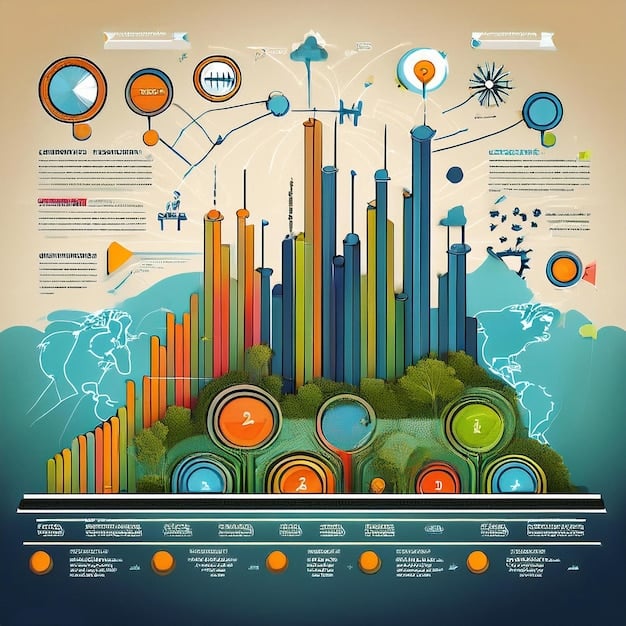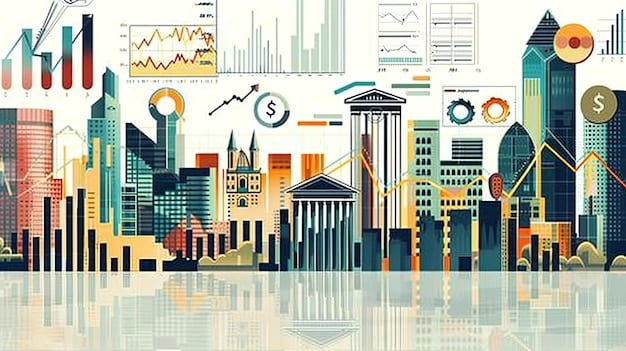2.8% GDP Growth in 2025: Impact on Your Investments

A projected 2.8% GDP growth in 2025 suggests a robust economic environment, influencing investment strategies through corporate earnings, interest rate shifts, and market sentiment, which could drive opportunities in various sectors while also presenting inflationary pressures.
Understanding how the projected 2.8% GDP growth in 2025 will impact your investments is crucial for strategic financial planning. This economic forecast, signaling a solid expansion, carries significant implications for various asset classes and investment approaches. It’s more than just a number; it’s a compass for navigating the opportunities and challenges ahead.
Decoding GDP Growth: The Economic Engine
Gross Domestic Product (GDP) growth is a primary indicator of a nation’s economic health, reflecting the total monetary value of all finished goods and services produced within its borders over a specific period. A projected 2.8% growth rate for 2025 signifies a healthy, albeit moderate, expansion, suggesting that businesses are producing more, consumers are spending, and the overall economy is on an upward trajectory. This metric is closely watched by investors because it often correlates with corporate profits, employment rates, and inflation, all of which directly influence investment performance.
However, the headline number alone doesn’t tell the whole story. It’s vital to dissect the components driving this growth. Is it primarily fueled by consumer spending, government expenditure, business investment, or net exports? The underlying drivers can signal different implications for various sectors. For instance, growth driven by strong consumer demand might benefit retail and services, while investment in infrastructure could boost industrial and materials sectors.
Understanding these nuances helps in formulating a more targeted investment strategy. A 2.8% growth rate suggests an economy expanding at a sustainable pace, potentially avoiding the overheating that could lead to aggressive interest rate hikes, or the stagnation that signals recessionary threats. This “sweet spot” of growth can be particularly beneficial for long-term investors seeking stable returns.
In essence, GDP acts as a critical benchmark. It allows investors to gauge the broader economic climate, anticipate potential market shifts, and adjust their portfolios accordingly. While not a perfect predictor, a consistent positive growth forecast provides a foundational layer for investment decisions, offering a glimpse into the likely trajectory of corporate profitability and market sentiment.
Impact on Corporate Earnings and Stock Market
A growing economy typically translates into increased corporate revenues and, subsequently, higher earnings. When GDP expands by 2.8%, businesses operating within that economy generally experience stronger demand for their products and services. This improved financial performance often reflects positively on their stock prices.
- 📈 Revenue Growth: Higher consumer spending and business investment directly boost sales.
- 💰 Profit Margins: Companies can often maintain or improve profit margins in a growing economy.
- 💡 Investor Confidence: Positive earnings reports tend to increase investor confidence, driving stock valuations.
Historically, a correlation exists between GDP growth and stock market performance, though it’s not always a direct one-to-one relationship. The stock market is forward-looking, often pricing in anticipated growth well before it materializes. Therefore, a 2.8% forecast for 2025 might already be partially reflected in current valuations. However, sustained growth could continue to fuel market optimism, particularly for companies that demonstrate strong execution and competitive advantages.
Investors should look beyond aggregate market performance and analyze individual sectors and companies. While the overall market might benefit, certain industries stand to gain more than others. Technology, consumer discretionary, and sectors benefiting from increased industrial activity might see accelerated growth, presenting specific investment opportunities. Conversely, defensive sectors might see relatively slower, though still stable, gains.
Interest Rates and Fixed Income Considerations
The projected 2.8% GDP growth in 2025 could influence interest rate policies by central banks. In an expanding economy, there’s always an underlying concern about inflation—too much money chasing too few goods. To combat potential inflationary pressures, central banks might consider raising interest rates. Higher interest rates typically aim to cool down an overheating economy by making borrowing more expensive, thereby reducing spending and investment.

For fixed-income investors, rising interest rates generally mean lower bond prices. This is because newly issued bonds would offer higher yields, making existing lower-yielding bonds less attractive. Investors holding long-term bonds could experience capital losses if they sell before maturity. However, for those looking to invest in fixed income, higher rates translate to more attractive yields on new bond purchases, providing better income generation over time.
Conversely, if growth is slow or accompanied by subdued inflation, central banks might maintain or even lower rates to stimulate economic activity. This scenario typically benefits bondholders, as existing bonds with higher fixed yields become more valuable. The 2.8% growth projection suggests a balanced scenario, possibly leading to a gradual and measured approach to interest rate adjustments rather than aggressive swings.
Real Estate Market Dynamics
The real estate market is highly sensitive to economic shifts, and a 2.8% GDP growth can bring a mix of positive and challenging dynamics. A robust economy generally boosts demand for housing, commercial properties, and rental spaces. Increased employment and higher wages, often a byproduct of economic expansion, can translate into greater purchasing power for consumers, fueling the residential real estate market.
- 🏠 Residential Real Estate: Stronger job market and consumer confidence boost home sales and prices.
- 🏢 Commercial Real Estate: Business expansion drives demand for office, retail, and industrial spaces.
- 💸 Rental Markets: Higher demand can lead to increased rental rates, benefiting property owners.
However, the relationship between GDP growth and real estate isn’t always linear. Rising interest rates, which central banks might implement in response to sustained economic growth to curb inflation, can dampen real estate activity. Higher mortgage rates make homeownership more expensive, potentially cooling down an overheated housing market. Commercial real estate might also face challenges if borrowing costs for development or acquisition become prohibitive.
The supply side also plays a crucial role. If new construction can keep pace with demand, price increases might be moderate. Conversely, limited supply in a growing economy can lead to significant appreciation in property values. Investors interested in real estate should consider both the macroeconomic indicators and local market conditions, as regional variations can be substantial even within a strong national economy.
In summary, while a 2.8% GDP growth paints a generally positive picture for real estate, careful consideration of interest rate movements and local supply-demand balances will be essential for making informed investment decisions in this sector.
Sector-Specific Opportunities and Risks
A projected 2.8% GDP growth creates a fertile ground for certain sectors while potentially posing challenges for others. Investors need to evaluate which industries are best positioned to capitalize on this economic expansion and which might face headwinds. This differentiation is key to optimizing investment portfolios in alignment with the growth trajectory.
Industries tied to consumer discretionary spending, such as retail, leisure, and automotive, often perform well during periods of economic expansion. As incomes rise and job security improves, consumers are more willing to spend on non-essential goods and services. Technology also tends to benefit from sustained growth, as businesses and consumers invest in innovative solutions to enhance productivity and lifestyle. Furthermore, sectors related to industrial production and infrastructure, such as manufacturing, construction, and materials, can experience heightened demand as businesses expand and governments invest in public projects.
On the other hand, defensive sectors like utilities, consumer staples, and healthcare, while generally stable, might see slower growth compared to more cyclical industries in a strong economic environment. These sectors are often sought out during downturns for their stable dividends and consistent demand, regardless of economic cycles. Moreover, a growing economy could lead to increased labor costs and supply chain pressures, impacting profitability for some businesses, especially those with thin margins or rigid cost structures.
Investors should conduct thorough due diligence, focusing on companies with strong balance sheets, competitive advantages, and the ability to adapt to changing economic conditions. Diversification across various sectors remains a prudent strategy to mitigate risks and capture opportunities arising from differentiated growth patterns.
Inflationary Pressures and Commodity Markets
The prospect of 2.8% GDP growth, while largely positive, rekindles discussions about potential inflationary pressures. As an economy expands, demand for goods and services typically increases. If supply cannot keep pace, prices tend to rise, leading to inflation. Inflation erodes purchasing power, making it a critical consideration for investors, especially regarding fixed returns and long-term asset values.
Commodity markets are often a bellwether for inflation. Increased economic activity usually translates into higher demand for raw materials such as oil, industrial metals, and agricultural products. Prices for these commodities tend to rise, acting as an input cost for many businesses and contributing to broader inflationary trends. Investors might look to commodities as a hedge against inflation, as their prices often appreciate during inflationary periods.
However, commodity markets are also subject to geopolitical events, supply disruptions, and speculative trading, which can complicate their relationship with economic growth. A balanced approach would involve monitoring inflation indicators closely, such as the Consumer Price Index (CPI) and Producer Price Index (PPI), and considering how these trends might influence investment returns across different asset classes. Gold, traditionally seen as a safe haven, also tends to perform well when inflation concerns are prevalent.
Understanding the interplay between GDP growth, inflation, and commodity prices is vital for diversifying a portfolio strategically. Allocating a portion of assets to commodities or inflation-protected securities could help safeguard purchasing power in an environment where growth potentially fuels price increases, requiring careful management of exposure.

The Role of Government Policy and Global Factors
The trajectory of 2.8% GDP growth in 2025 will not solely be an organic economic phenomenon but will also be significantly shaped by government policy and broader global factors. These external forces can either amplify or mitigate the projected growth, thereby influencing investment outcomes across the board. Investors must remain vigilant about these dynamics, as they can introduce both opportunities and risks that are separate from internal market forces.
Government fiscal and monetary policies are paramount. Fiscal measures, such as tax rates, public spending on infrastructure, and social programs, can directly stimulate aggregate demand and enhance productive capacity. For instance, targeted investments in renewable energy or technology research can foster growth in specific sectors. Monetary policy, orchestrated by the central bank, primarily through interest rate management and quantitative easing or tightening, controls the money supply and credit conditions. A cooperative stance between fiscal and monetary authorities, aimed at fostering sustainable growth while managing inflation, would be highly beneficial for stability and investment confidence.
Global factors, including geopolitical stability, international trade relations, and the health of major economies, also play a crucial role. Supply chain resilience, trade agreements, and even regional conflicts can impact commodity prices, import/export dynamics, and investor sentiment. A stable global environment, characterized by open trade and diplomatic cooperation, tends to support national economic growth projections. Conversely, increased protectionism, trade wars, or widespread geopolitical instability could introduce significant headwinds, affecting everything from corporate earnings to currency valuations. Hence, a holistic view that considers both domestic policy actions and the broader international context is essential for investors looking to navigate the 2025 economic landscape effectively.
| Key Area | Investment Impact |
|---|---|
| 📈 Stock Market | Generally positive due to higher corporate earnings and investor confidence. |
| 📊 Fixed Income | Potential for rising interest rates could lower bond prices but offer better new yields. |
| 🏡 Real Estate | Increased demand, but potentially higher mortgage rates could be a dampener. |
| ⚙️ Commodities | Higher demand and potential inflation could drive commodity prices up. |
Frequently Asked Questions About 2025 GDP Growth
A 2.8% GDP growth rate signifies a healthy and sustainable economic expansion. It suggests increased production, consumption, and investment across the country. Such growth typically correlates with job creation, rising incomes, and overall economic stability, providing a positive backdrop for investment and business activity. It indicates a robust economic environment without necessarily overheating.
Generally, a 2.8% GDP growth rate is highly favorable for the stock market. It typically leads to increased corporate earnings as businesses experience higher sales and improved profitability. This surge in earnings often translates into higher stock prices and boosted investor confidence. While the market is forward-looking, sustained growth can fuel continued optimism and valuation increases, especially in cyclical sectors.
A 2.8% GDP growth carries the potential for moderate inflationary pressures, as increased demand can push prices higher if supply lags. In response, central banks might consider gradual interest rate hikes to manage inflation. While this could lead to lower bond prices for existing fixed-income investments, it also means new bonds would offer more attractive yields for investors, balancing market dynamics.
Sectors that tend to perform well during periods of 2.8% GDP growth include consumer discretionary (e.g., retail, leisure), technology, and industrial sectors (e.g., manufacturing, construction). These industries often thrive on increased consumer spending, business investment, and overall economic activity. Investors should also consider the financial sector, which benefits from improved lending conditions and economic vitality.
Long-term investors should consider maintaining a diversified portfolio, potentially increasing exposure to growth-oriented stocks and sectors poised to benefit from economic expansion. While traditional hedges like fixed income or gold might still have a place, a stronger focus on quality companies with sustainable competitive advantages in growing industries could be beneficial. Regular review and rebalancing remain key for adjusting to evolving market conditions.
Conclusion
The projected 2.8% GDP growth for 2025 paints a picture of a robust and expanding economy, offering both fertile ground for investment opportunities and areas requiring careful navigation. From boosting corporate earnings and potentially fueling stock market gains to influencing interest rates, real estate dynamics, and commodity prices, this outlook demands a strategic approach from investors. Understanding the nuanced impacts across different sectors and asset classes, while considering the overarching influence of government policies and global factors, will be paramount. By staying informed and adapting their portfolios intelligently, investors can position themselves to benefit from this anticipated economic expansion, ensuring their financial strategies align with the prevailing economic winds of 2025.





